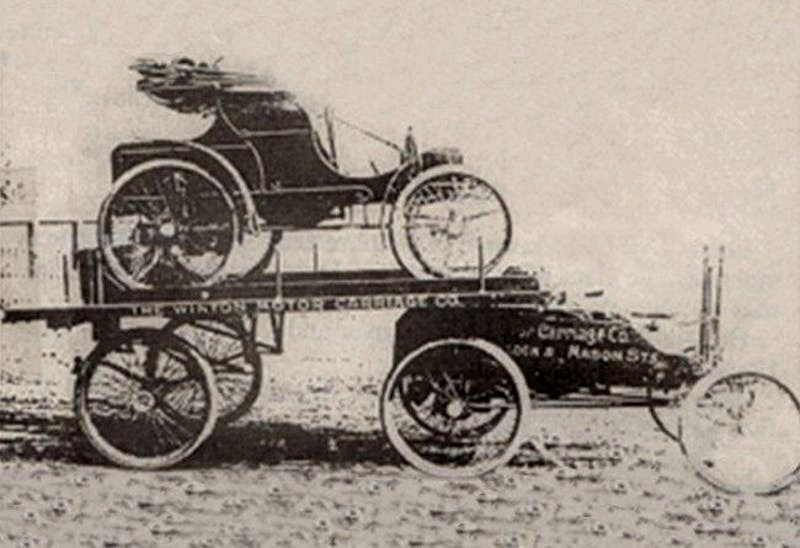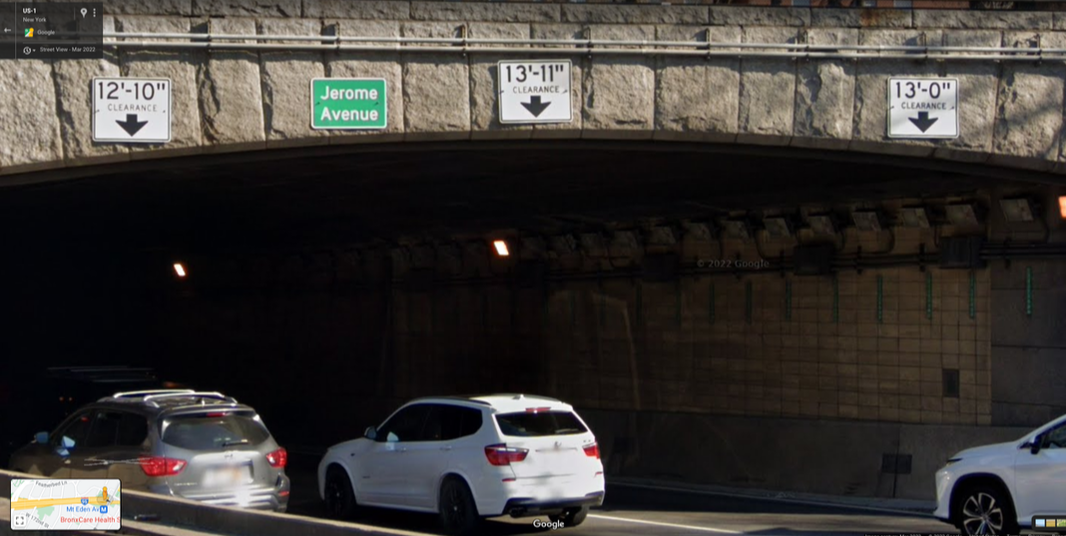|
Living in a fifth wheel has its pluses and minuses. If we could change anything about it, we’d make it shorter. Our 13-foot, 3-inch height makes it tricky to navigate a lot of areas, including state campgrounds. We always have to be on alert for low-hanging branches and low-clearance bridges. The Northeast U.S. is notorious for low-clearance bridges. When its towns and cities were established in the 1600s, most people got around on foot. If they had to travel great distances, they would take a stagecoach. Although New York’s first bridge emerged in 1693 to connect Manhattan and the Bronx, most bridges didn’t appear until the 1800s. At that time, tall vehicles didn’t exist. Early Semi-Trucks The first semi-truck came on the scene in 1898. Alexander Winton designed it specifically to deliver a car on a trailer to its buyer somewhere in the country. This eliminated wear and tear on the vehicle from driving it to its purchaser. In 1914, August Charles Fruehauf invented a more substantial semi-trailer to transport his boat. It was later adapted to move lumber. As automobiles became more popular, car dealers needed more efficient ways to deliver the vehicles to purchasers. So, in the 1930s, George Cassens crafted a trailer that could carry four cars at a time. Between 1929 and 1944, Mack Trucks entered the market, creating 2,601 semi trailers. Peterbilt trucks followed in 1939 to transport logs. These early semis paled in comparison to today’s mammoth 18-wheelers that stand 13 feet, 5 inches tall. It wasn’t until 1983 that trailers stretched as long as 48 feet, only 7 feet shy of today’s standard 53 feet. Increasing RV Heights Early campers weren’t much taller than the trucks pulling them. Even initial fifth-wheel campers averaged 8 to 8.5 feet tall. Many original models required people to crawl up to the bed over the top of the truck bed. Gradually, fifth wheels increased in height to about 10 feet, making them easier to live in for a weekend or vacation getaway. RV manufacturers started installing slideouts in fifth wheels in the 1990s to create more living space. Providing adequate ceiling height in these slideouts meant the supporting rig around the slideouts had to be taller. The average height of a modern fifth wheel RV is 13 feet, with many as tall as 13 feet, 5 or 6 inches. Today, towering RVs and semi-trucks roam the highways. Although the width of these vehicles is limited to 102 inches (8 feet, 6 inches) in the U.S., according to the U.S. Department of Transportation, there’s no nationwide vehicle height limit. That varies per state, typically between 13 feet, 6 inches and 14 feet. Maneuvering Roadways In New York City, arched bridges force high-clearance vehicles to drive in the middle lane to ensure they can clear. They’re prevented from certain roadways, where clearance is too low for safe passage. New York also lists clearances as 6 to 12 inches lower than the height of vehicles that can clear safely — unless the bridge says ACTUAL CLEARANCE. We found this out when we approached a bridge labeled 12’-11” and watched a standard semi pass through unharmed. We followed suit. Rumor has it this height discrepancy is to allow for safe passage even when roads are packed with snow. Low-clearance challenges aren’t limited to New York. They span all of New England too. Athol, Massachusetts, for example, has an overpass that’s only safe for vehicles 12-foot, 7 inches or less to maneuver. For some reason, a semi-truck driver tried to take the route. Maybe he thought the actual clearance was 13 feet, 7 inches, like in New York. His trailer hit hard, denting the top, and creating a loud boom. Ensuring Safe Passage
Most road atlases don’t display bridge and tunnel clearances. Similarly, although Google Maps does a good job showing us the quickest, most direct route between two points, it doesn’t take into consideration the height and length of our vehicle. Because of that, we can’t always trust that Google will navigate us safely, as the trucker in Athol discovered. For better results, we use an app called CoPilot. Its $30 annual fee is well worth the peace of mind it provides. We’re able to enter our vehicle dimensions and select if we want to use toll roads, ferries, propane-restricted routes, and more. Based on our choices, the app directs us safely to any destination we enter. Only one time we questioned the route CoPilot directed us to after a white-knuckled drive through winding roads in northeastern Tennessee. Other than that, we’ve fared well. We also make a point to look at the satellite view on Google Maps of any destination we choose and the path to get there to ensure it’s navigable for a rig our size. You might also enjoy Answers to Your Questions About Our RV Lifestyle.
4 Comments
Mom
6/21/2022 07:31:35 am
Great research and informative!
Reply
Betty Schoen
6/21/2022 03:14:06 pm
Wow. Great info! It makes sense that bridges in the east would be smaller/lower, as so many were built so much longer ago than what's here in the west. Glad you all are staying in one piece!
Reply
Kelly
6/21/2022 04:15:22 pm
Very interesting! Thanks for the history and historical picture!
Reply
7/5/2022 06:34:11 am
There's whole youtube channels showing trucks getting their trailer roofs peeled back like a sardine can from these low bridges. Its amazing how many drivers aren't mindful of this. Safe travels Gulliver.
Reply
Leave a Reply. |
AuthorThis is the travel blog of full-time RVers Bob and Lana Gates and our truck, Gulliver, and fifth wheel, Tagalong. Categories
All
Archives
July 2024
|





 RSS Feed
RSS Feed